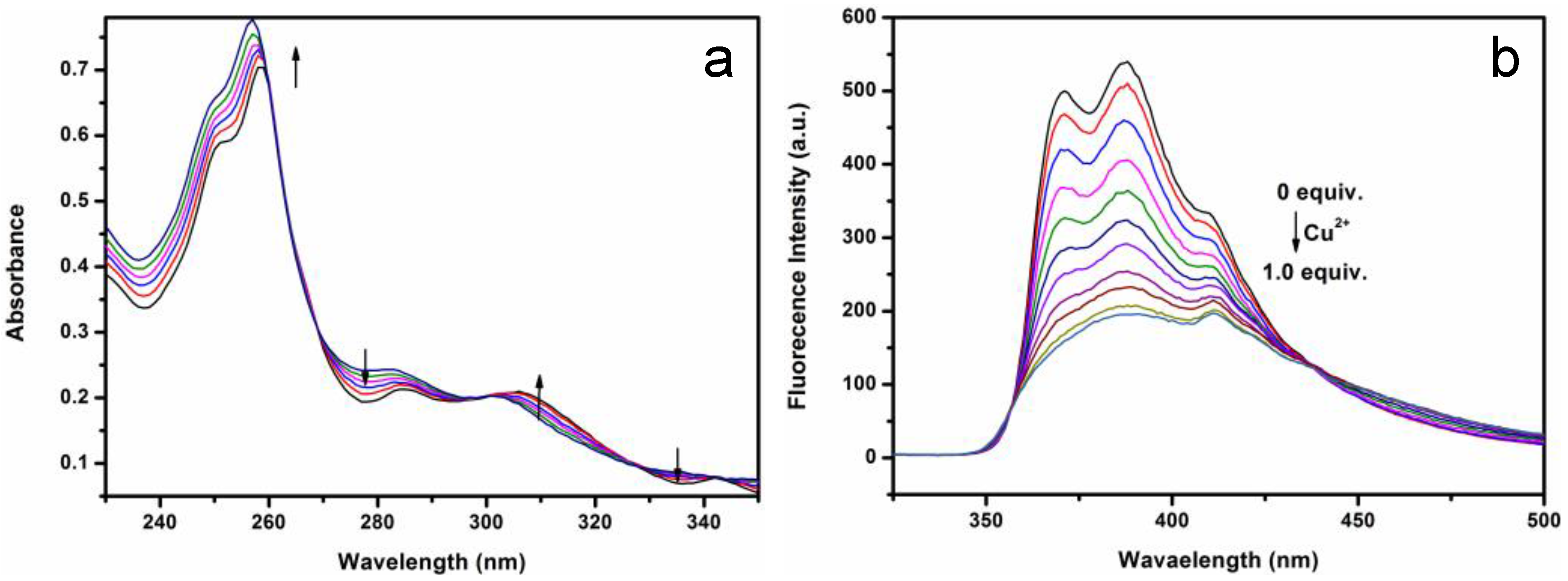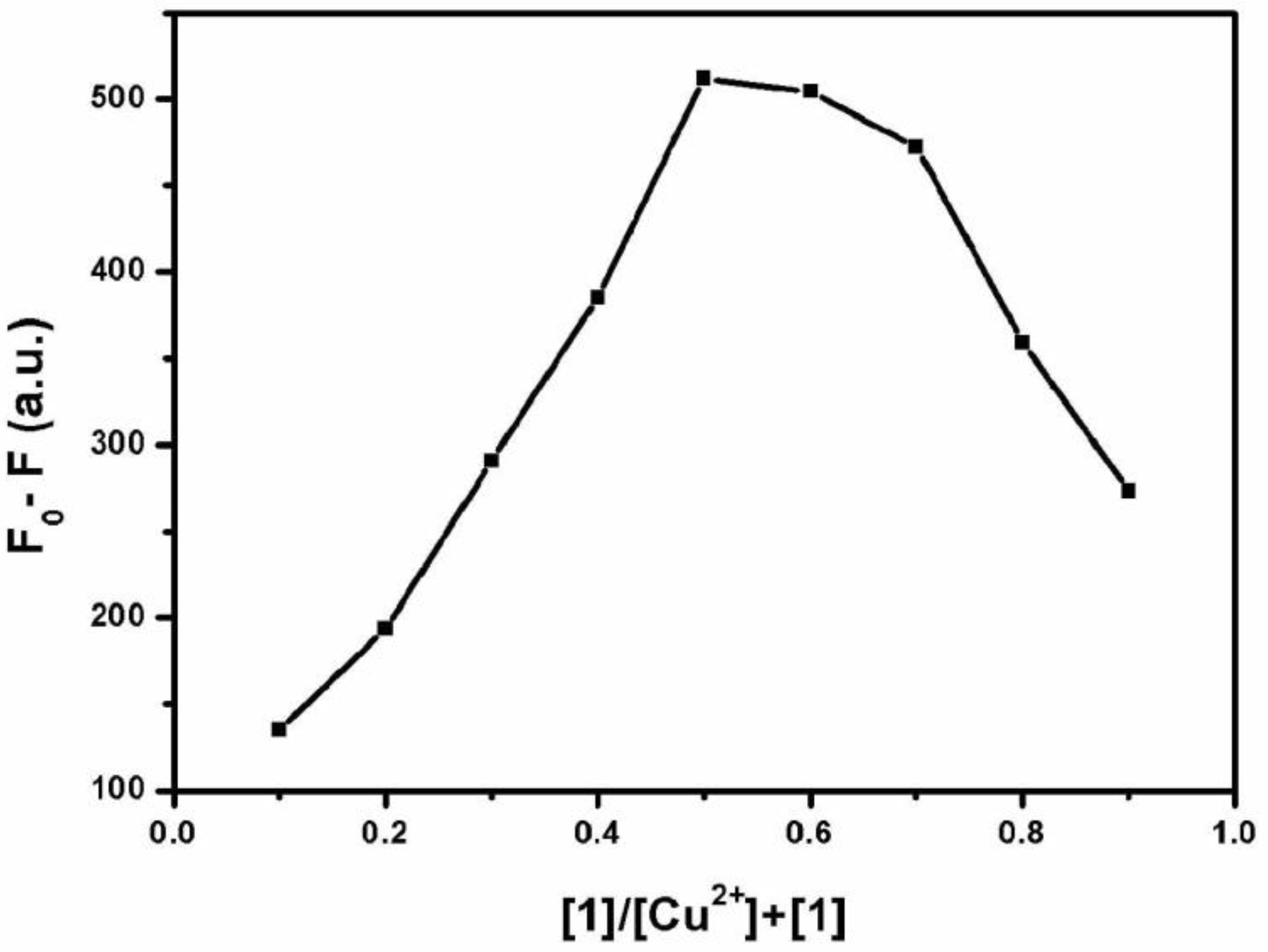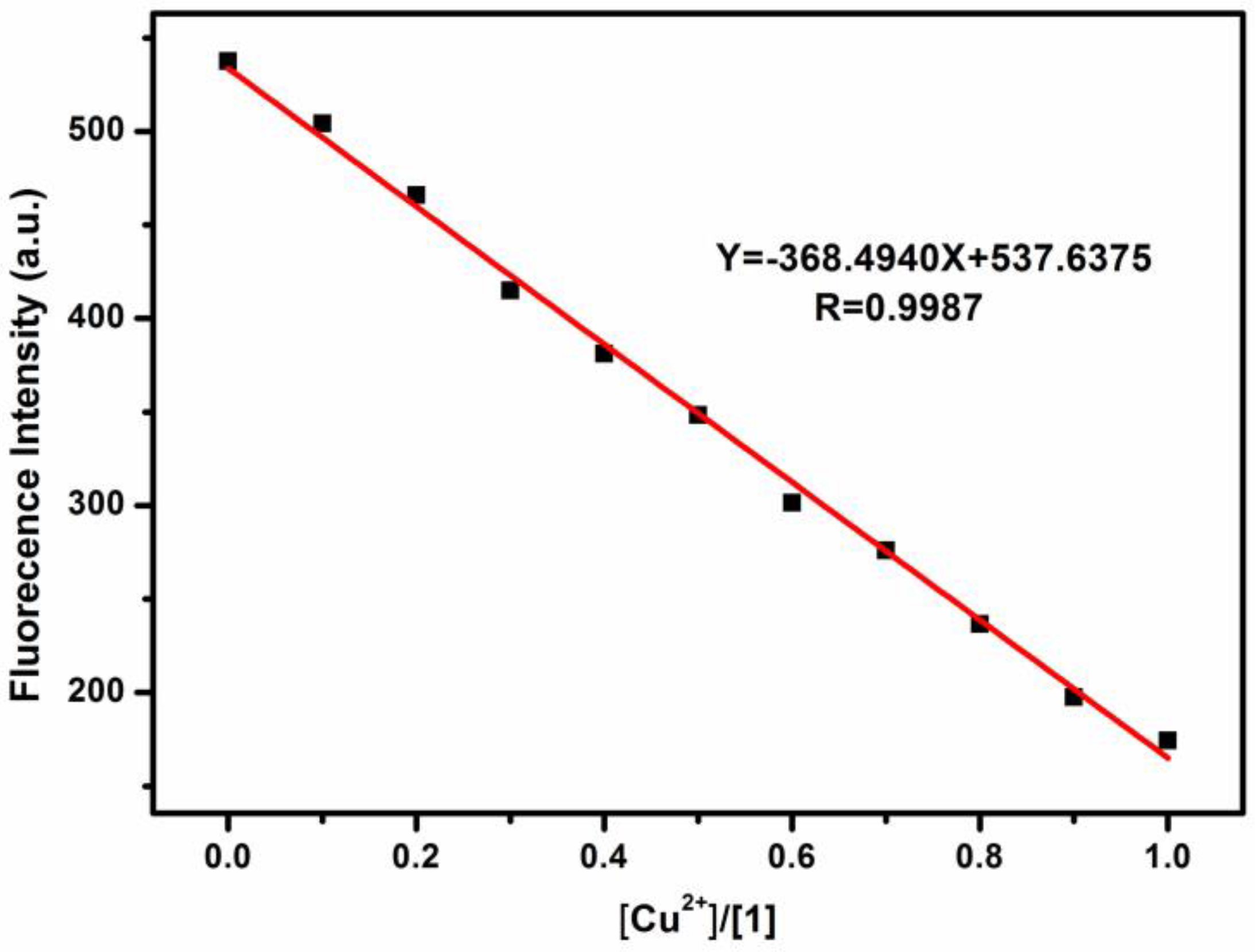A Cu2+-Selective Probe Based on Phenanthro-Imidazole Derivative
Abstract
:1. Introduction
2. Experimental
2.1. Materials and Methods
2.2. Synthesis
2.3. Spectral Measurements
3. Results and Discussion
3.1. UV-Vis Spectral Response of the Binding between Probe 1 and Cu2+
3.2. Stoichiometric Ratio of Probe 1-Cu2+ Complex
3.3. Fluorescence Quenching Selectivity
3.4. Detection Limit
4. Conclusions
Supplementary Materials
Acknowledgments
Author Contributions
Conflicts of Interest
References
- Trapaidze, A.; Hureau, C.; Bal, W.; Winterhalter, M.; Faller, P. Thermodynamic study of Cu2+ binding to the DAHK and GHK peptides by isothermal titration calorimetry (ITC) with the weaker competitor glycine. J. Biol. Inorg. Chem. 2012, 17, 37–47. [Google Scholar] [CrossRef] [PubMed]
- Hötzer, B.; Ivanov, R.; Brumbarova, T.; Bauer, P.; Jung, G. Visualization of Cu2+ uptake and release in plant cells by fluorescence lifetime imaging microscopy. FEBS J. 2012, 279, 410–419. [Google Scholar] [CrossRef] [PubMed]
- Ghaedi, M.; Tavallali, H.; Keshavarz, M.; Niknam, K. Determination of Copper and Zinc Ions by Flame-AAS After Preconcentraction Using Sodium Dodecyl Sulfate Coated Alumina Modified with 3-((1H-Indol-3-yl)-3,4,5-trimethyl)-1H-indole. Chin. J. Chem. 2009, 27, 2066–2072. [Google Scholar] [CrossRef]
- Yang, X.; Wang, E. A Nanoparticle Autocatalytic Sensor for Ag+ and Cu2+ Ions inAqueous Solution with High Sensitivity and Selectivity andIts Application in Test Paper. Anal. Chem. 2011, 83, 5005–5011. [Google Scholar] [CrossRef] [PubMed]
- Jiang, X.C.; Yu, A.B. Silver Nanoplates: A Highly Sensitive Material toward InorganicAnions. Langmuir 2008, 24, 4300–4309. [Google Scholar] [CrossRef] [PubMed]
- Jiang, X.C.; Yu, A.B. Low Dimensional Silver Nanostructures: Synthesis, Growth Mechanism, Properties and Applications. J. Nanosci. Nanotechnol. 2010, 10, 7829–7875. [Google Scholar] [CrossRef] [PubMed]
- Carter, K.P.; Young, A.M.; Palmer, A.E. Fluorescent Sensors for Measuring Metal Ions in Living Systems. Chem. Rev. 2014, 114, 4564–4601. [Google Scholar] [CrossRef] [PubMed]
- Masilamany, K.; Ramaier, N. L-Cysteine-capped ZnS quantum dots based fluorescence sensor for Cu2+ ion. Sens. Actuators B Chem. 2009, 139, 104–109. [Google Scholar]
- Shyamaprosad, G.; Debabrata, S.; Nirmal, K.D. A New Highly Selective, Ratiometric and Colorimetric Fluorescence Sensor for Cu2+ with a Remarkable Red Shift in Absorption and Emission Spectra Based on Internal Charge Transfer. Org. Lett. 2010, 12, 856–859. [Google Scholar]
- Liu, X.J.; Zhang, N.; Bing, T.; Shangguan, D.H. Carbon Dots Based Dual-Emission Silica Nanoparticles as a Ratiometric Nanosensor for Cu2+. Anal. Chem. 2014, 86, 2289–2296. [Google Scholar] [CrossRef] [PubMed]
- Chen, W.B.; Tu, X.J.; Guo, X.Q. Fluorescent gold nanoparticles-based fluorescence sensor for Cu2+ ions. Chem. Commun. 2009. [Google Scholar] [CrossRef] [PubMed]
- Guo, Z.Q.; Zhu, W.H.; Tian, H. Hydrophilic Copolymer Bearing Dicyanomethylene-4H-pyran Moiety As Fluorescent Film Sensor for Cu2+ and Pyrophosphate Anion. Macromolecules 2010, 43, 739–744. [Google Scholar] [CrossRef]
- Hariharan, P.S.; Anthony, S.P. Substitutional group dependent colori/fluorimetric sensing of Mn2+, Fe3+ and Zn2+ ions by simple Schiff base chemosensor. Spectrochim. Acta A 2015, 136, 1658–1665. [Google Scholar] [CrossRef] [PubMed]
- Grynkiewicz, G.; Poenie, M.; Tsien, R.Y. A New Generation of Ca2+ Indicators with Greatly Improved Fluorescence Properties. J. Biol. Chem. 1985, 260, 3440–3450. [Google Scholar] [PubMed]
- He, G.J.; Guo, D.; He, C.; Zhang, X.L.; Zhao, X.W.; Duan, C.Y. A Color-Tunable Europium Complex Emitting Three Primary Colors and White Light. Angew. Chem. Int. Ed. 2009, 48, 6132–6135. [Google Scholar] [CrossRef] [PubMed]
- Huang, J.H.; Xu, Y.F.; Qian, X.H. A red-shift colorimetric and fluorescent sensor for Cu2+ in aqueous solution: Unsymmetrical 4, 5-diaminonaphthalimide with N-H deprotonation induced by metal ions. Org. Biomol. Chem. 2009, 7, 1299–1303. [Google Scholar] [CrossRef] [PubMed]
- Madhu, S.; Ravikanth, M. Boron-Dipyrromethene Based Reversible and Reusable Selective Chemosensor for Fluoride Detection. Inorg. Chem. 2014, 53, 1646–1653. [Google Scholar] [CrossRef] [PubMed]
- Lin, K.K.; Wu, S.C.; Hsu, K.M.; Hung, C.H.; Liaw, W.F.; Wang, Y.M. A N-(2-Aminophenyl)-5-(dimethylamino)-1-naphthalenesulfonic Amide (Ds-DAB) Based Fluorescent Chemosensor forPeroxynitrite. Org. Lett. 2013, 16, 4242–4245. [Google Scholar] [CrossRef] [PubMed]
- Hu, B.; Hu, L.L.; Chen, M.L.; Wang, J.H. A FRET ratiometric fluorescence sensing system for mercury detection and intracellular colorimetric imaging in live Hela cells. Biosens. Bioelectron. 2013, 49, 499–505. [Google Scholar] [CrossRef] [PubMed]
- Goswami, S.; Maity, S.A.; Maity, A.; Maity, A.K.D.; Saha, P.A. A FRET-based rhodamine–benzimidazole conjugate as a Cu2+-selective colorimetric and ratiometric fluorescence probe that functions as a cytoplasm marker. RSC Adv. 2014, 4, 6300–6305. [Google Scholar] [CrossRef]
- Zhang, X.; Shirashi, Y.; Hirai, T. Cu(II)-Selective Green Fluorescence of a Rhodamine-Diacetic Acid Conjugate. Org. Lett. 2007, 9, 5039–5042. [Google Scholar] [CrossRef] [PubMed]
- Grasso, G.I.; Gentile, S.; Giuffrida, M.L.; Satriano, C.; Sgarlata, C.; Sgarzi, M.; Tomaselli, G.; Arena, G.; Prodi, L. Ratiometric fluorescence sensing and cellular imaging of Cu2+ by a new water soluble trehalose-naphthalimide based chemosensor. RSC Adv. 2013, 3, 24288–24297. [Google Scholar] [CrossRef]
- Boiocchi, M.; Fabbrizzi, L.; Licchelli, M.; Sacchi, D.; Vazquez, M.; Zampa, C. A two-channel molecular dosimeter for the optical detection of copper (II). Chem. Commun. 2003, 21, 1812–1813. [Google Scholar] [CrossRef]
- Royzen, M.; Dai, Z.; Canary, J.W. Ratiometric Displacement Approach to Cu (II) Sensing by Fluorescence. J. Am. Chem. Soc. 2005, 127, 1612–1613. [Google Scholar] [CrossRef] [PubMed]
- Martinez, R.; Espinosa, A.; Tarraga, A.; Molina, P. New Hg2+ and Cu2+ Selective Chromoand Fluoroionophore Based on a Bichromophoric Azine. Org. Lett. 2005, 7, 5869–5872. [Google Scholar] [CrossRef] [PubMed]
- An, R.B.; Zhang, D.T.; Chen, Y.; Cui, Y.Z. A “turn-on” fluorescent and colorimetric sensor for selective detection of Cu2+ in aqueous media and living cells. Sens. Actuators B Chem. 2016, 222, 48–54. [Google Scholar] [CrossRef]
- Wang, H.L.; Zhou, G.D.; Chen, X.Q. An iminofluorescein-Cu2+ ensemble probe for selective detection of thiols. Sens. Actuators B Chem. 2013, 176, 698–703. [Google Scholar] [CrossRef]
- Huang, J.G.; Liu, M.; Ma, X.Q.; Dong, Q.; Ye, B.; Wang, W.; Zeng, W.B. A highly selective turn-off fluorescent probe for Cu(II) based on a dansyl derivative and its application in living cell imaging. RSC Adv. 2014, 4, 22964–22970. [Google Scholar] [CrossRef]
- Almesåker, A.; Bourne, S.A.; Ramon, G.; Scotta, J.L.; Strauss, C.R. Coordination chemistry of N,N,4-tris(pyridin-2-ylmethyl)aniline: A novel flexible, multimodal ligand. CrystEngComm 2007, 9, 997–1010. [Google Scholar] [CrossRef]
- Peng, X.J.; Du, J.J.; Fan, J.L.; Wang, J.Y.; Wu, Y.K.; Zhao, J.Z. A Selective Fluorescent Sensor for Imaging Cd2+ in Living Cells. J. Am. Chem. Soc. 2007, 129, 1500–1501. [Google Scholar] [CrossRef] [PubMed]
- Zhao, W.Q.; Liu, X.L.; Lv, H.T.; Fu, H.; Yan, Y.; Huang, Z.P.; Han, A.X. A phenothiazine–rhodamine ratiometric fluorescent probe for Hg2+ based on FRET and ICT. Tetrahedron Lett. 2015, 56, 4293–4298. [Google Scholar] [CrossRef]
- Huang, L.; Cheng, J.; Xie, K.; Xi, P.; Hou, F.; Li, Z.; Xie, G.; Shi, Y.; Liu, H.; Bai, D.; et al. Cu2+-selective fluorescent chemosensor based on coumarin and its application in bioimagin. Dalton Trans. 2011, 40, 10815–10817. [Google Scholar] [CrossRef] [PubMed]
- Han, A.X.; Liu, X.H.; Prestwich, G.D.; Zang, L. Fluorescent sensor for Hg2+ detection in aqueous solution. Sens. Actuators B Chem. 2014, 198, 274–277. [Google Scholar] [CrossRef]






© 2016 by the authors; licensee MDPI, Basel, Switzerland. This article is an open access article distributed under the terms and conditions of the Creative Commons Attribution (CC-BY) license (http://creativecommons.org/licenses/by/4.0/).
Share and Cite
Cheng, D.; Liu, X.; Yang, H.; Zhang, T.; Han, A.; Zang, L. A Cu2+-Selective Probe Based on Phenanthro-Imidazole Derivative. Sensors 2017, 17, 35. https://doi.org/10.3390/s17010035
Cheng D, Liu X, Yang H, Zhang T, Han A, Zang L. A Cu2+-Selective Probe Based on Phenanthro-Imidazole Derivative. Sensors. 2017; 17(1):35. https://doi.org/10.3390/s17010035
Chicago/Turabian StyleCheng, Dandan, Xingliang Liu, Hongzhi Yang, Tian Zhang, Aixia Han, and Ling Zang. 2017. "A Cu2+-Selective Probe Based on Phenanthro-Imidazole Derivative" Sensors 17, no. 1: 35. https://doi.org/10.3390/s17010035





